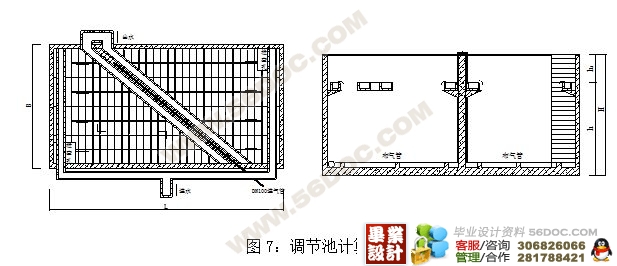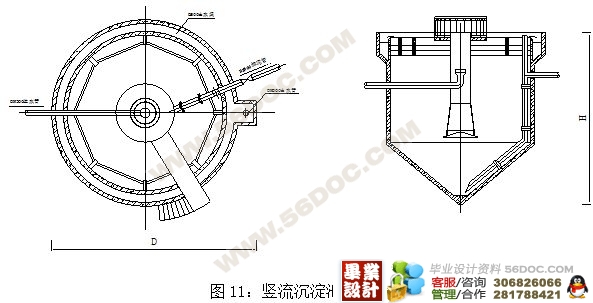摘 要
本设计题目为“某厂废水污水处理工程工艺设计”,该工程所处理的污水主要是由染色废水和洗线、洗毯、刺绣车间废水组成。经建设方确认,本设计规模按日最大处理水量:2500 m3/d(包括处理站自用水排水量)。污水主要污染物CODcr、SS、BOD5、S2-、色度等,其污水水质如下:染色废水:CODcr=1495mg/L,BOD5=340mg/L,SS=540mg/L,S2-=1.35-2.16mg/L,PH=3.7-8.62,色度=300倍;洗线、洗毯、刺绣车间废水:CODcr=480mg/L,BOD5=300mg/L,SS=200mg/L,S2-=1.2mg/L,PH=3.7-8.62,色度=50倍。冬季平均温度-14.9℃ ,夏季平均温度为29.2℃,年平均降水量427.1mm,冬季主导风向为西北,夏季主导风向为东南。处理站处理水质为:BOD5≦20mg/l,CODcr≦100mg/l,SS≦70mg/l,PH=6-9,色度≤50倍,出水水质符合国家的二级排放标准。
本设计采用水解酸化加生物接触氧化处理废水。处理构筑物主要有调节池、水解酸化池、生物接触氧化池、竖流式沉淀池、浓缩池、泵房、脱水机房和鼓风机房等。其主要构筑物生物接触氧化池采用传统的一段式接触氧化,总共采用两座,每座分为八格,处理效果明显。预处理的调节池和水解酸化池有效的降低了污水的各项指标,为生物接触氧化池的进水,提供了最佳进水指标,同时还有效的降低了污水的色度,再加上后面的竖流式沉淀池的絮凝沉淀作用,色度指标大大降低,基本上可以满足出水的要求。
关键词:印染废水 废水处理 生物接触氧化
ABSTRACT
The design entitled "Xuanhua a woolen mill wastewater treatment process design," The works are mainly treated sewage effluent from dyeing and washing lines, washing blankets, embroidery workshop wastewater components. Confirmed by the construction side, the design of handling the largest-scale water daily : 2500 cubic meters per day (including water discharge from the station). Sewage major pollutants CODcr, SS, BOD5, S2-, color, the effluent quality are as follows : dyeing wastewater : CODcr=1495mg/L, BOD5=340mg/L, SS=540mg/L. S2-=1.35-2.16mg/L, pH=3.7-8.62, color 300 times; washing line, washing blankets, embroidery workshop wastewater:CODcr=480mg/L, BOD5=300mg/L. SS=200mg/L, S2-=1.2mg/L, PH=3.7-8.62. color 50 times. The average winter temperature -14.9 ℃, average summer temperature of 29.2 ℃, with the average rainfall 427.1mm. Winter winds led to the northwest, the summer winds led to the southeast. Water Disposal Station : BOD5 ≦ 20mg/l, CODcr ≦ 100mg/l, SS ≦ 70mg/l, PH=6-9, color ≦ 50, the effluent quality in the state's two emission standards.
The design acid hydrolysis Biological oxidation wastewater treatment. Dealing with the main structures regulation pool, pool acid hydrolysis, biological oxidation pond, the vertical flow sedimentation tank, concentrated pool, pumping stations, Dehydration room and the other blower. The main structures of biological oxidation pond used for the traditional contact-oxidation, using a total of two, each divided into eight blocks. significant treatment effect. Pretreatment Regulation pools and pool acid hydrolysis effectively reduce the sewage indicators of biological oxidation pond inundated. Intake provides the best indicator, but also effectively reduce sewage color, plus behind the vertical flow sedimentation tank of flocculation and sedimentation, color indicators greatly reduced. Basically meet water requirements.
Keywords : dyeing wastewater wastewater treatment biological oxidation




目 录
第1章 概述 6
1.1设计依据及设计任务 6
1.1.1设计题目 6
1.1.2设计依据 6
1.2设计水量 8
1.3处理程度 8
1.4去除率 8
第2章 污水处理站方案的确定 9
2.1确定污水处理方案的原则 9
2.2 污水处理方案的确定 9
2.2.1处理标准的确定 9
2.2.2污水处理路线选择 9
2.3 污水处理工艺流程方案介绍 11
2.3.1 传统活性污泥法 11
2.3.2氧化沟工艺 12
2.3.3生物接触氧化工艺 13
2.4工艺流程的确定 14
2.5 主要构筑物的选择 14
2.5.1 格栅 14
2.5.2 进水闸井 14
2.5.3调节池 15
2.5.4 污水泵房 15
2.5.5水解酸化池 16
2.5.6生物接触氧化池 19
2.5.7沉淀池 21
2.5.8 浓缩池 22
2.5.9 污泥脱水 23
第3章 污水处理系统的设计计算 23
3.1进水格栅间的设计 23
3.1.1粗格栅 23
3.1.2细格栅 24
3.2调节池的设计 26
3.2.1调节池的设计计算 26
3.3集水井与污水提升泵的设计 27
3.4水解酸化池的设计 28
3.4.1水解酸化池的设计计算 28
3.5配水井的设计 29
3.5.1配水井的设计计算 29
3.6生物接触氧化池的设计 30
3.6.1生物接触氧化池的设计计算 30
3.7沉淀池的设计 32
3.7.1竖流沉淀池的设计计算 32
第4章 污泥处理系统设计计算 34
4.1污泥浓缩脱水 34
4.1.1污泥浓缩池的设计参数 34
4.1.2污泥浓缩池的设计计算 34
4.2污泥脱水 35
第5章 其他构筑物设计计算 36
5.1鼓风机房 36
5.2脱水机房 36
5.3泵房 37
5.4综合办公楼 37
5.5计量设施 37
第6章 高程设计计算 37
第7章 处理站的整体布置 40
7.1 平面布置及总平面图 40
7.1.1 平面布置的一般原则 40
7.1.2 站区平面布置形式 41
7.1.3 污水站平面布置的具体内容 41
7.2 污水站的高程布置 41
7.2.1 污水处理站高程布置应考虑事项 41
7.2.2污水站的高程布置 42
7.2.3污水站的高程计算 42
第8章 供电仪表与辅助设施设计 42
8.1变配电系统 42
8.2监测仪表的设计 42
8.2.1 设计原则 42
8.2.2 检测内容 42
8.3辅助设施和相关专业工程设计 43
8.4工程施工 43
第9章 人员编制与运行管理 43
9.1生产组织 43
9.2劳动定员 43
9.3安全与卫生 43
9.3.1安全生产管理 43
9.3.2 安全生产制度 43
9.3.3 绿化、卫生管理 43
参考文献 45
致 谢 46
|

